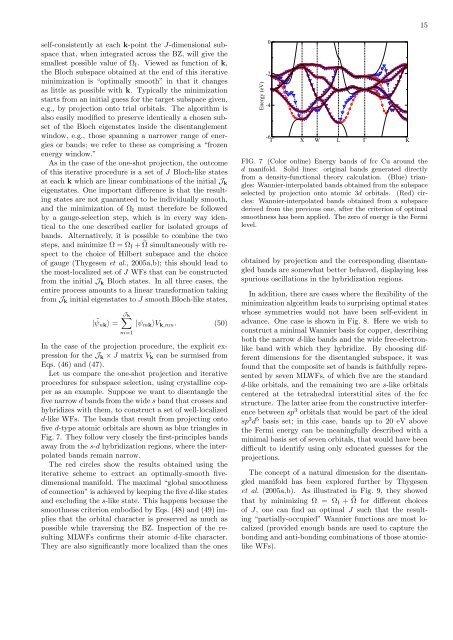Maximally localized Wannier functions: Theory and applications
Maximally localized Wannier functions: Theory and applications
Maximally localized Wannier functions: Theory and applications
Create successful ePaper yourself
Turn your PDF publications into a flip-book with our unique Google optimized e-Paper software.
15<br />
self-consistently at each k-point the J-dimensional subspace<br />
that, when integrated across the BZ, will give the<br />
smallest possible value of Ω I . Viewed as function of k,<br />
the Bloch subspace obtained at the end of this iterative<br />
minimization is “optimally smooth” in that it changes<br />
as little as possible with k. Typically the minimization<br />
starts from an initial guess for the target subspace given,<br />
e.g., by projection onto trial orbitals. The algorithm is<br />
also easily modified to preserve identically a chosen subset<br />
of the Bloch eigenstates inside the disentanglement<br />
window, e.g., those spanning a narrower range of energies<br />
or b<strong>and</strong>s; we refer to these as comprising a “frozen<br />
energy window.”<br />
As in the case of the one-shot projection, the outcome<br />
of this iterative procedure is a set of J Bloch-like states<br />
at each k which are linear combinations of the initial J k<br />
eigenstates. One important difference is that the resulting<br />
states are not guaranteed to be individually smooth,<br />
<strong>and</strong> the minimization of Ω I must therefore be followed<br />
by a gauge-selection step, which is in every way identical<br />
to the one described earlier for isolated groups of<br />
b<strong>and</strong>s. Alternatively, it is possible to combine the two<br />
steps, <strong>and</strong> minimize Ω = Ω I + ˜Ω simultaneously with respect<br />
to the choice of Hilbert subspace <strong>and</strong> the choice<br />
of gauge (Thygesen et al., 2005a,b); this should lead to<br />
the most-<strong>localized</strong> set of J WFs that can be constructed<br />
from the initial J k Bloch states. In all three cases, the<br />
entire process amounts to a linear transformation taking<br />
from J k initial eigenstates to J smooth Bloch-like states,<br />
| ˜ψ nk ⟩ =<br />
∑J k<br />
m=1<br />
|ψ mk ⟩V k,mn . (50)<br />
In the case of the projection procedure, the explicit expression<br />
for the J k × J matrix V k can be surmised from<br />
Eqs. (46) <strong>and</strong> (47).<br />
Let us compare the one-shot projection <strong>and</strong> iterative<br />
procedures for subspace selection, using crystalline copper<br />
as an example. Suppose we want to disentangle the<br />
five narrow d b<strong>and</strong>s from the wide s b<strong>and</strong> that crosses <strong>and</strong><br />
hybridizes with them, to construct a set of well-<strong>localized</strong><br />
d-like WFs. The b<strong>and</strong>s that result from projecting onto<br />
five d-type atomic orbitals are shown as blue triangles in<br />
Fig. 7. They follow very closely the first-principles b<strong>and</strong>s<br />
away from the s-d hybridization regions, where the interpolated<br />
b<strong>and</strong>s remain narrow.<br />
The red circles show the results obtained using the<br />
iterative scheme to extract an optimally-smooth fivedimensional<br />
manifold. The maximal “global smoothness<br />
of connection” is achieved by keeping the five d-like states<br />
<strong>and</strong> excluding the s-like state. This happens because the<br />
smoothness criterion embodied by Eqs. (48) <strong>and</strong> (49) implies<br />
that the orbital character is preserved as much as<br />
possible while traversing the BZ. Inspection of the resulting<br />
MLWFs confirms their atomic d-like character.<br />
They are also significantly more <strong>localized</strong> than the ones<br />
Energy (eV)<br />
0<br />
-2<br />
-4<br />
-6<br />
Γ X W L Γ K<br />
FIG. 7 (Color online) Energy b<strong>and</strong>s of fcc Cu around the<br />
d manifold. Solid lines: original b<strong>and</strong>s generated directly<br />
from a density-functional theory calculation. (Blue) triangles:<br />
<strong>Wannier</strong>-interpolated b<strong>and</strong>s obtained from the subspace<br />
selected by projection onto atomic 3d orbitals. (Red) circles:<br />
<strong>Wannier</strong>-interpolated b<strong>and</strong>s obtained from a subspace<br />
derived from the previous one, after the criterion of optimal<br />
smoothness has been applied. The zero of energy is the Fermi<br />
level.<br />
obtained by projection <strong>and</strong> the corresponding disentangled<br />
b<strong>and</strong>s are somewhat better behaved, displaying less<br />
spurious oscillations in the hybridization regions.<br />
In addition, there are cases where the flexibility of the<br />
minimization algorithm leads to surprising optimal states<br />
whose symmetries would not have been self-evident in<br />
advance. One case is shown in Fig. 8. Here we wish to<br />
construct a minimal <strong>Wannier</strong> basis for copper, describing<br />
both the narrow d-like b<strong>and</strong>s <strong>and</strong> the wide free-electronlike<br />
b<strong>and</strong> with which they hybridize. By choosing different<br />
dimensions for the disentangled subspace, it was<br />
found that the composite set of b<strong>and</strong>s is faithfully represented<br />
by seven MLWFs, of which five are the st<strong>and</strong>ard<br />
d-like orbitals, <strong>and</strong> the remaining two are s-like orbitals<br />
centered at the tetrahedral interstitial sites of the fcc<br />
structure. The latter arise from the constructive interference<br />
between sp 3 orbitals that would be part of the ideal<br />
sp 3 d 5 basis set; in this case, b<strong>and</strong>s up to 20 eV above<br />
the Fermi energy can be meaningfully described with a<br />
minimal basis set of seven orbitals, that would have been<br />
difficult to identify using only educated guesses for the<br />
projections.<br />
The concept of a natural dimension for the disentangled<br />
manifold has been explored further by Thygesen<br />
et al. (2005a,b). As illustrated in Fig. 9, they showed<br />
that by minimizing Ω = Ω I + ˜Ω for different choices<br />
of J, one can find an optimal J such that the resulting<br />
“partially-occupied” <strong>Wannier</strong> <strong>functions</strong> are most <strong>localized</strong><br />
(provided enough b<strong>and</strong>s are used to capture the<br />
bonding <strong>and</strong> anti-bonding combinations of those atomiclike<br />
WFs).













